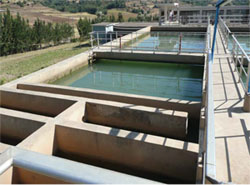14.5 Large-scale water treatment
Large-scale or municipal water treatment is not common in rural communities but you may find it in larger towns and cities where there is a network of pipes and pumps to distribute water from the treatment works. There are several steps in municipal water treatment intended to remove solids, kill pathogenic organisms and make water safe to drink. The main stages are usually aeration, sedimentation, coagulation, filtration and disinfection.
Aeration simply means to mix air with the water. It is used to remove volatile (easily evaporated) substances from drinking water. Air and water are put into contact with each other, i.e. air is bubbled through the water, so that the volatile substances are evaporated into the airstream and removed from the water. Aeration can be carried out in towers or aeration basins to provide the necessary contact time between air and water. Sedimentation is the settling out of comparatively heavy suspended material (suspended solids) in water because of gravity. The settling takes place in a quiet pond or a specially constructed tank (Figure 14.10). A minimum 24-hour retention time is necessary to have a significant reduction in suspended matter. (Retention time means the length of time the water is kept (retained) in the tank.) Sedimentation can be used alone or in combination with coagulation.

Coagulation is the formation of particles in a liquid by adding chemicals. Its meaning is similar to flocculation. The flocculant used in large-scale treatment plants is usually alum (hydrated aluminum sulphate). This chemical is mixed with turbid water and then allowed to remain still in a sedimentation tank or basin so that the larger particles, or floc, settle to the bottom.
Filtration is the removal of suspended material from water as it passes through beds of porous material. This is exactly the same principle as filtration methods at household level. Filters can be made of layers of sand, gravel or charcoal. Filtration cannot completely remove all bacteria.
Disinfection kills most harmful organisms including pathogenic bacteria. Without disinfection, the risk from waterborne disease will remain. Disinfecting agents include chlorine, ultraviolet light, ozone, iodine and others but, of these, chlorine is the most frequent treatment agent. The process is called chlorination.
14.4 Safe storage
